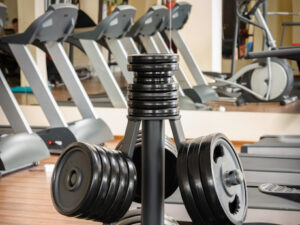This post originally appeared on Wisconsin Tai Chi Academy’s website and is reproduced with permission.
I’ve been involved in exercise of one form or another for most of my life, whether it was playing sports, weight training at the gym, martial arts training, or simply enjoying long walks and hikes. This became even more so as I became a physical therapist – exercise literally became the way I made my living.
One of the key principles of effective exercise is ensuring that you have effective strategies for recovery following exercise. Recovery is important because it is what helps the body make positive adaptations and thus gain the benefit from the exercise being performed. Without proper recovery, exercise may do more harm than good – this is why many sports and high level exercise programs have ‘rest’ days to allow the body to adapt and heal following exercise. If you’ve engaged in any sort of sport and exercise you’re probably familiar with stretching after exercise to avoid injury, though exercise science research continues to argue whether stretching is effective for recovery. Elite level athletes often use ‘cross-training’ activities – that is activities and exercises not necessarily related to their actual sport – as a form of recovery from their regular training, and the research has demonstrated that this has benefits to their overall performance and ability to improve.
Tai Chi and Qigong are both well known for their wide range of benefits as forms of exercise. Clinical research is increasingly demonstrating evidence that Tai Chi and Qigong are useful adjuncts to other forms of exercise in maximizing the overall effects and outcomes of exercise or rehabilitation programs. Most research tends to take place in health-compromised populations, for example, those with specific illness or conditions (eg: Parkinson’s Disease, cancer, etc.), those with recent trauma or injury (eg: after stroke, heart attack, etc.) and those who are at risk of decline as a part of the aging process. Yet there hasn’t been a lot of investigation on Tai Chi and Qigong in already healthy/fit populations, nor does there appear to be any research looking at the benefits Tai Chi and Qigong could have in post-exercise recovery. Given the multitude of benefits already demonstrated by Tai Chi and Qigong in terms of gains in strength, flexibility, balance, and mental and emotional wellbeing, it seems reasonable to expect that Tai Chi and Qigong would be very effective in facilitating post-exercise recovery. I started to look into this with my own exercise, and my experience tells me we need to be examining this more closely.
My Experience with Tai Chi and Qigong Following Exercise
I first started weight training when I was about 15 years old and have engaged in this kind of training on and off ever since, including now. As such, I’m very familiar with the soreness and fatigue that comes from a good weights session, and the importance of allowing adequate recovery time to avoid injury and facilitate adaptive changes in the body.
About 10 years ago I had the opportunity to recommence a gym program focused on both building strength and weight reduction after a considerable time away from this type of exercise. My program consisted both anaerobic (mostly free weights training) and aerobic (treadmill, cross-trainer/elliptical or rowing machine) exercises. When I committed to starting the program I knew I would be starting from a low level and it would take time to build up to where I had previously been, and I knew what I was in for, especially in those early weeks! The difference this time, though was that I planned to practice my Tai Chi and Qigong sets after I exercised.
At the time my only intention for including Tai Chi and Qigong practice was to spend more practicing these sets by taking opportunity of the time I was setting aside for exercise. I had not considered that there could be any sort of specific benefit to practicing my Tai Chi and Qigong after exercise beyond ensuring that I was getting my practice in!
My experience was almost immediate, to the point where it took me a little while to make any sort of connection. The first week of starting my program, I noticed that I was not experiencing the level of soreness or fatigue I was expecting from the gym sessions. This is not to say I didn’t experience any, just not anywhere near what I expected. I put this down to the idea that I was “easing back into it” and not working out as hard as I potentially could. I felt this was a reasonable approach, though I was keen to make gains, and so from the second week on I started to challenge myself.
As the weeks went on though, I realized that I was making gains – in terms of increased strength (increasing the resistance of my exercises) and stamina (increasing the time spent on aerobic exercises) at a faster rate than I had ever previously achieved. More than that, rather than feel fatigued at the end of an exercise session, I felt energized and the soreness I experienced was minimal. I started to wonder if my Tai Chi and Qigong could explain what was happening, so I tried a little experiment. For one week, I continued with my gym program but did not practice my Tai Chi and Qigong afterwards – though I did continue to practice them at my regular classes twice a week.
Again, the effect was almost instantaneous. After the second session of the week I felt more sore and more fatigued. Not only that, but I felt ‘stiff’ and ‘tight’, like I needed a good stretch. I particularly found my aerobic components became more laborious and harder to maintain at the level I had been doing. By midway through the week I was so convinced I wanted to restart my Tai Chi and Qigong practice just so I wouldn’t feel this way after a workout, however I persisted with abstaining from it for the week in an attempt to try and confirm (at least to myself) what was happening.
When I restarted my Tai Chi and Qigong practice after exercising the following week, everything went back to the way it was: less soreness, less tiredness, and feeling ‘good’ after each session. To me there seemed to be a clear link between the two.
I must admit this is by no means any sort of proof that Tai Chi and Qigong can assist with post-exercise recovery – at best it’s anecdotal evidence – but as a physical therapist and a student of exercise science, I believe it’s enough to warrant further investigation through clinical research.
Possible Explanations for How Tai Chi and Qigong Facilitate Post-Exercise Recovery
Assuming the benefits I experienced are a result of including Tai Chi and Qigong practice following exercise, what could the possible explanation be? The immediate consideration relates to the flow of qi in the body, and way that Tai Chi and Qigong improve qi flow, and the subsequent benefits this has on one’s health. However, Western science still struggles with the concept of qi, and though evidence is growing in support of biofield medicine (a term used to explain the effects of energies known as qi, prana, mana, etc.), at this time it’s likely that any clinical research will want a more ‘physiological’ explanation in order to validate any evidence that becomes apparent through studies. In my own consideration of this, I would suggest Tai Chi and Qigong practice post-exercise could influence the following mechanisms:
- improved clearance of waste metabolites formed during exercise;
- enhanced circulation and efficiency of the cardiovascular system;
- improved action and efficiency of the immune system;
- enhanced restoration of a normal/resting physiological state (heart rate, blood pressure, respiratory rate, etc.) post-exercise; and/or
- enhanced restoration of psychological/emotional state post-exercise.
This is by no means an exhaustive list, however I feel it is a reasonable starting place for clinical research and one that would be relatively easy for experienced researchers in exercise and sports sciences to develop studies for.
A Call for Further Research
With the increasing evidence of the benefits of Tai Chi and Qigong across the health and wellness spectrum, as well as their relative ease of application (no need for costly or special equipment, for example), it only makes sense to investigate the potential practices could have on enhancing the effects of exercise. If it can be demonstrated that Tai Chi and Qigong can enhance post-exercise recovery, and this in turn enhances ability for people to participate in exercise programs, imagine the potential this has for exercise in all settings: from school-based sports and athletics programs, to rehabilitation programs, to elite level athletic performance. Tai Chi and Qigong could be a game changer in a very literal sense.
Wisconsin Tai Chi Academy, and our Instructor Ray Gates, welcomes the opportunity to partner with and assist any researchers wanting to investigate the effects and benefits of Tai Chi and Qigong, whether related to post-exercise recovery or otherwise. If you have a study or project you would like our involvement with, please use this link to Contact Us.


